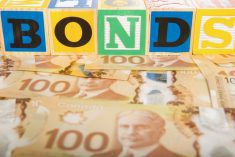As I write, it is almost the second anniversary of the titanium-strength portfolio. I am updating as of May 4, 2020, due to publication timelines. With the topsy-turvy nature of markets lately, the details may have changed by publication date, but the key message will remain the same.
The normally volatile markets have been unusually erratic these past two years, since inception. After a relatively benign first four months, markets entered a major correction or minor bear market beginning in September and culminating on Christmas Eve of 2018. During that three-month period the S&P 500 declined 20 per cent with the TSX faring slightly better.
Read Also

Gentle treatments for pain in the neck
Heading toward year-end, people unknowingly tense up against the cold and busyness, causing neck pain that can often be treated with appropriate support and gentle mobility, athletic therapist Kathlyn Hossack says.
Markets recovered and excelled in 2019, recording total returns of 31.5 and 22.9 per cent for the S&P 500 and TSX, respectively. This year began with continued strength but when COVID-19 surfaced, markets fell through a trap door, experiencing the fastest decline in history — even faster than at any time during the Great Depression. During an excruciating four-week period, markets swung wildly, periodically in excess of 10 per cent in a day, ending down about 35 per cent. At the time of writing, markets have quickly recovered half those losses. Whew … and what a test for the titanium-strength portfolio.
Through the tumult of the past two years, the portfolio has returned 8.4 per cent (up 13.5 in the first year and down 5.1 in the second) in Canadian dollar terms. That isn’t the normal ten per cent average annual returns, but better than the weighted average of the U.K., U.S. and Canadian markets, which gained just one per cent in Canadian dollar terms. While the return was subpar, it’s hard to find GICs yielding four per cent.
Last year, while debriefing the account on its first anniversary, I mentioned it would be very difficult to predict next year’s star and laggard. Indeed, the top first-year performer, Disney, was the worst performer during the second year, although through no fault of its own. Disney continued to perform well but has a lot of travel-related assets, theme parks and cruise boats. Travel stocks have been absolutely decimated by COVID, with Disney standing up well in comparison. On the Canadian side, Fortis has been the top performer both years. Dividends represent the entire gain to date.
For the first time since beginning this simulation portfolio, I am reinvesting the Canadian dividends. Using the $50 remaining after the initial investments and $2,536 of dividends, I added 540 shares of iShares S&P/TSX Energy ETF (exchange-traded fund), with the ticker symbol XEG. While I don’t own this ETF, I own many of the constituent companies.
My next article will discuss ETFs in detail. In short, they are funds which trade like stocks, holding all companies in a specific index, which in this case is the TSX Capped Energy Index. XEG owns 22 of the largest oil and gas producers in Canada. Currently valued at about 20 per cent of its peak value in 2008, oil producers have suffered a myriad of issues, declining prices and government policy headwinds. Every time it looked like the industry was improving with light at the end of the tunnel, that light turned into an oncoming train, most recently COVID. At some point the industry will rebound.
Through the turmoil, a few positive signs have emerged. TC Energy has confirmed building Keystone XL. The Canadian portion of Enbridge’s Line 3 is complete, with targeted completion of the U.S. portion in 2020. Trans Mountain (now way over budget … go figure) is targeted for 2022. Irving oil, a vocal proponent of Energy East that was shuttered because of a changing and onerous regulatory environment, is now trying to “import” oil from Alberta through another route. It plans to load oil tankers in British Columbia and sail through the Panama Canal to their refinery in Saint John, N.B. Lastly, the CEO of Quebec-based National Bank recently spoke in support of a Canadian energy policy, co-ordinated with the United States, to reduce Eastern Canadian reliance on Saudi oil. If these are all more oncoming trains, I might give up on Canadian energy, but not until then!
The portfolio demonstrates how solid investment returns, significantly better than many alternatives, can be derived with minimal effort. Adding XEG is the first change made since inception two years ago.

















